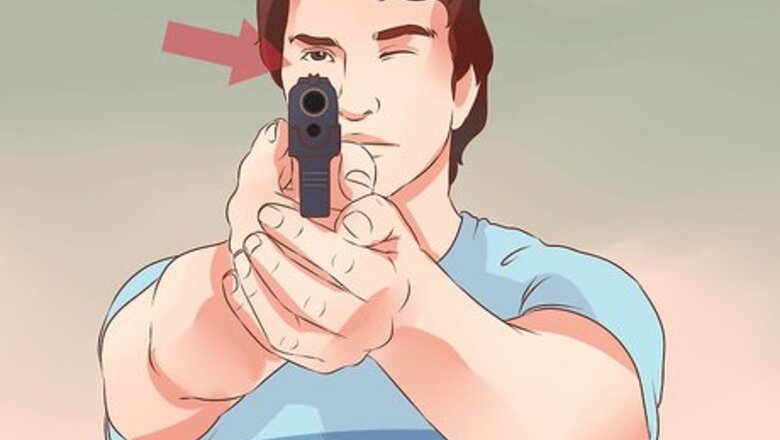
views
- Use your dominant eye to aim while keeping the front and back sights of your pistol aligned.
- Avoid moving your hands while you shoot.
- Watch for grip and handling errors by monitoring how your bullet shoots.
- Hold your gun with both hands, stand in the extended shooting position, and aim carefully.
Aiming Essentials
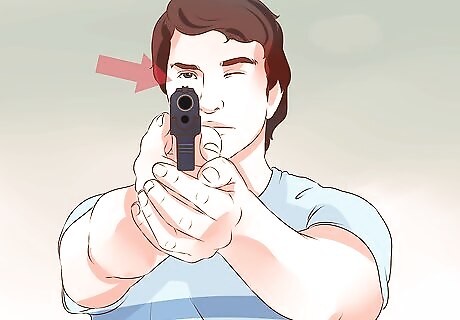
Aim with your dominant eye. Aiming with both eyes is next to impossible, so you need to take aim with your dominant eye. Your dominant eye presents a more accurate picture of your surroundings than your non-dominant eye. Your dominant eye is usually lines up with your dominant hand, but this is not always the case. To determine which eye is your dominant one, form a 1-inch (2.5-cm) circle with your thumb and index finger. Hold the circle at arm's length and look through it to a distant object. Gradually bring the circle toward your face with both eyes open, but do not look at it. You hand will naturally move toward your dominant eye.
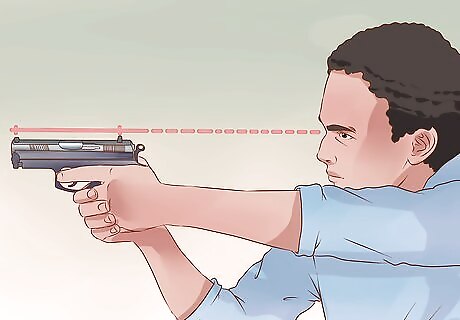
Align the front and back sights. A pistol has a rear sight and a front sight. When aiming the gun, the post of the front sight should be evenly centered in between the two posts of the rear sight. The front sight consists of a single post and the back sight consists of two posts. There needs to be an equal amount of space to the left and the right of the front sight. The top of the front sight should also be flush or even with the tops of the back sight posts.

Focus your eyes on the gun. As you aim the pistol, you will need to look at the rear sight, front sight, and the target. It is physically impossible for your eyes to focus on all three objects at once, though. In order to aim the gun properly, you need to make sure that your eyes are focused on the gun sights and not the target. The target should look a little blurry. You should still be able to see it, but it should fall to the background and look much less crisp than the gun sights appear. More specifically, you should be focusing on your front sight. The front sight lets you know what your gun's relative position to the target is.
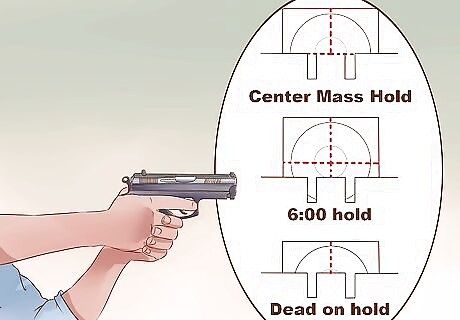
Choose your point of aim. There are three acceptable points of aim. No single option is officially better than the others, so you'll need to test them each out to determine which works best for you. For the center hold or center of mass aim, place the top of the front sight at the center of the target. The top should run through the horizontal center of the target. For the 6 o'clock aim, place the top of the front sight just below the bullseye area. If using an actual shooting target, the top of the front sight will overlap the bottom of the black bullseye. For the sub-6 aim, you will need to place the top of the front sight even further below the bullseye area. When using actual shooting targets, the top of the sight will be roughly in the middle of the white portion below the black bullseye area.
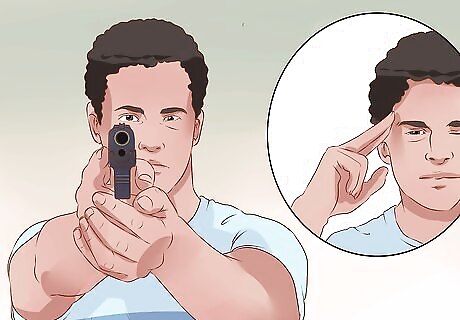
Concentrate. Aiming a pistol requires patience and concentration. Sloppy aim will result in a sloppy shot. Before firing the pistol, make sure your shots are correctly aligned. Be patient when pressing the trigger. If you feel anxious about firing the gun and concentrate on applying more pressure to the trigger, even for a moment, you will lose concentration on your aim and will probably have a poor shot.
Common Mistakes
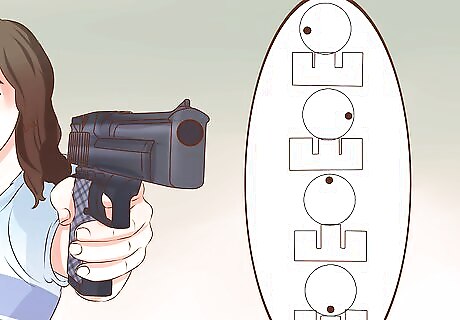
Identify angular shift errors. An angular shift error occurs when the sights are not properly aligned. You can usually determine if you are making a consistent angular error based on the placement of your bullet in the target. If the bullet hits below the center of the target, the top of the front sight may have shifted below the tops of the back sight posts. If the bullet hits above the center of the target, the top of the front sight may have shifted above the tops of the back sight posts. If the bullet hits right of center, the front sight might be closer to the right side of the back sight. If the bullet hits left of center, the front sight might be closer to the left side of the back sight. Focus on the front sight to improve your aim. "I used to incorrectly line up the rear and front sights, leading with the rear. After reading this article, I learned to properly lead with the front sight and follow with the rear. My shot groups have tightened up a lot at the range thanks to this little tip." - Rick F. Experience isn't everything. "Even after shooting pistols for over 50 years, this article helped me brush up on some fundamentals. The reminders on determining eye dominance and basic sight alignment were super helpful for this seasoned shooter." - Mike S. Learn which eye is dominant. "I honestly wasn't 100% positive which eye was dominant before reading this. Using that simple eye test picture let me know I should actually be aiming with my left eye. I'm certain my next session is going to go more smoothly now that I know which eye to line the sights up with." - Al B. You can shoot well even with small hands. "As someone with really small hands, I always struggle to get a solid grip on any pistol. This article confirms some advice my coach gave me about proper trigger control, like using as much finger as I can. Knowing to pull straight back instead of squeezing also really helps me get cleaner shots." - Ashley B. Make sure to consistently refresh your fundamentals. "Even as an experienced shooter, I found this article to be a great refresher on proper pistol fundamentals. From stance and grip to sight alignment and trigger control, it covers the key bases whether you're new to pistols or simply want a quick skills brush-up." - Eric L. Have a story our readers should hear? Share it with 1 billion+ annual wikiHow users. Tell us your story here.
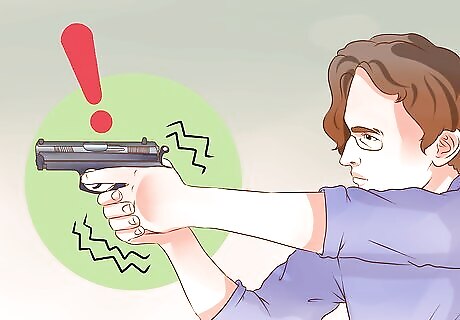
Pick out a parallel shift error. Parallel shift errors occur when your sights are properly aligned, but your hand moves as you fire. Holding the pistol still results in the most accurate shot, but typically, parallel shift errors do not disrupt your aim as much as angular shift errors do. Parallel shift errors almost always result from your wrist either breaking up or breaking down, so the placement of your shot will usually be either just above center or just below it, respectively.
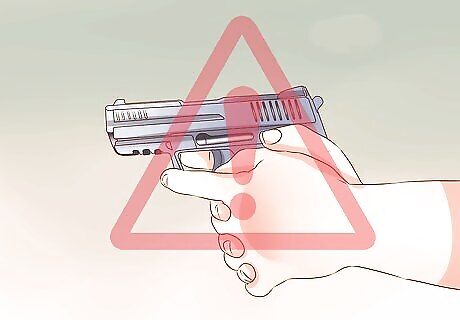
Spot grip and handling errors. Shift errors are not the only problems you might encounter. The placement of your bullet in the target could also indicate a handful of other problems. If the bullet hits out of center and closer to your dominant side, you could be squeezing your thumb or using too much trigger finger. Similarly, if it falls to the other side of the center, you might be using too little trigger finger. If it falls to the lower right for right-handed shooters, or vice versa for left-handed shooters, you could be tightening your grip while pulling the trigger. If it falls to the lower left, you could be tightening your fingers or jerking the trigger. If the bullet lands to the upper right for right-handed shooters, or vice versa for left-handed shooters, you might be anticipating recoil in your shot. If it goes to the upper left, you might be anticipating recoil or lacking follow through.
Putting It All Together
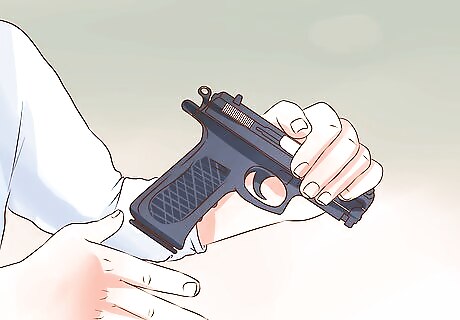
Grip the gun on the back strap with your dominant hand. Your dominant hand should be placed high along the back strap—the back of your pistol's grip—with your thumb to the inside of the barrel. Your middle, ring, and pinky fingers should wrap around the outside and front of the grip. Your index finger should rest against the outside of the trigger guard. This position give you the maximum amount of leverage against the gun. When you fire the pistol, it will recoil, and good leverage is an important part of keeping your hand steady.
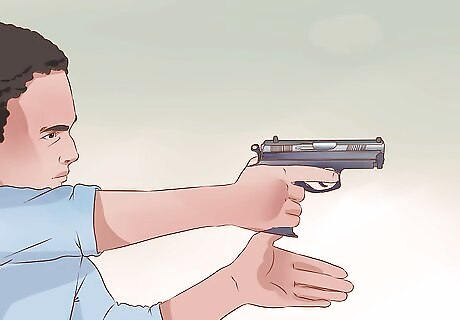
Place your non-dominant hand against the exposed grip. Your non-dominant hand is your support hand, and the way you position this hand will add further support and leverage against the recoil of your firing pistol. Place the support hand as high as possible around the grip. All four fingers should be under the trigger guard, and the index finger should press the bottom outside of the guard firmly. The thumb should point forward and meet with your other thumb on the opposite side of the gun.
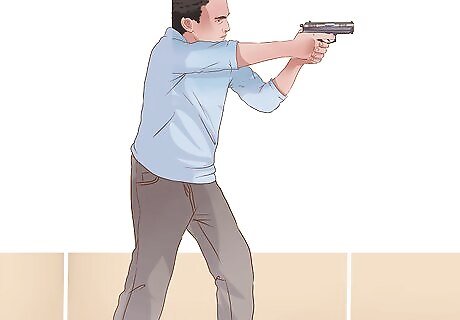
Take the extended shooting position. Stand with your feet planted firmly on the ground and pointed in the direction of your target. Your feet should be shoulder width apart, and your knees should be slightly bent. This stance makes it easy to move yet provides you with stability. Grab your pistol and raise it up until it is positioned in front of you. Your arms should be straight out and slightly bent at the elbows, and the gun should be nowhere near your face.
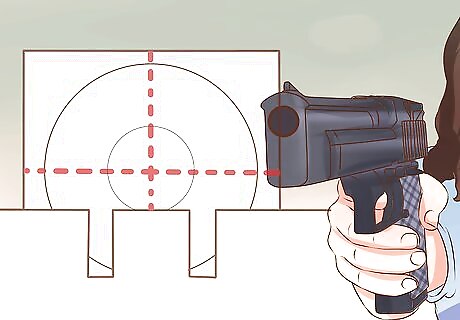
Aim the pistol. Follow the instructions provided in this article to aim the pistol at your target properly.
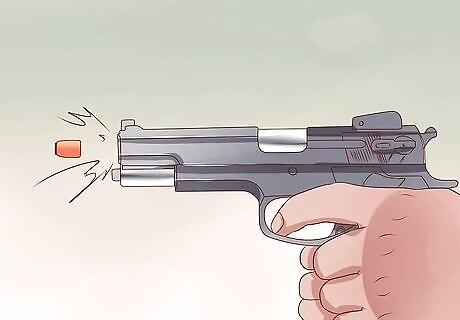
Press the trigger until the pistol fires. Instead of "pulling" the trigger, you need to press or squeeze the trigger in a controlled fashion. Press the trigger straight to the rear using a constant pressure. Only use pressure on the front of the trigger and not on the sides. Squeeze the trigger until you start feeling resistance to take the slack out of it. Continue pressing the trigger in this manner until the pistol shoots. Try not to anticipate when this will happen, since doing so often leads to a last-minute error in aim.













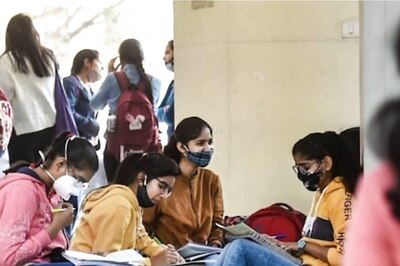





Comments
0 comment